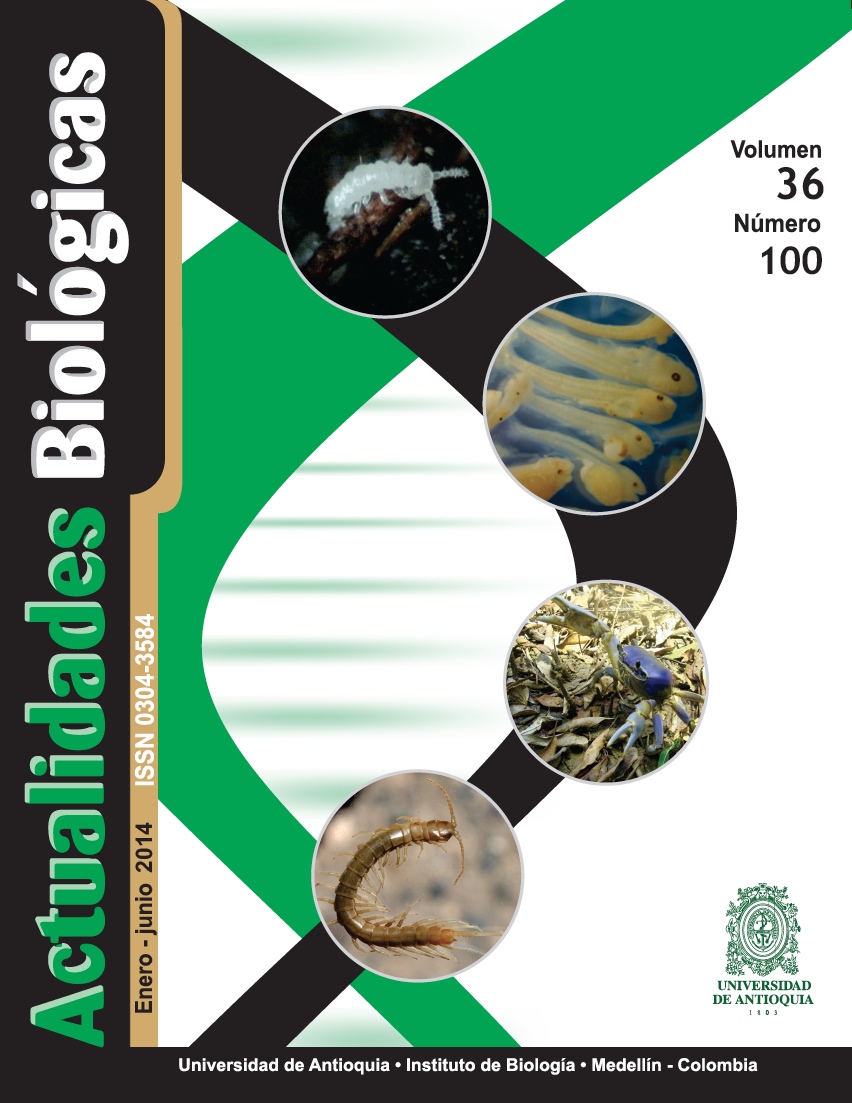On the availability of the name Cuniculus hernandezi Castro, López, and Becerra, 2010 (Rodentia: Cuniculidae)
DOI:
https://doi.org/10.17533/udea.acbi.329110Keywords:
Cuniculus, name-bearing type, nomenclature, taxonomyAbstract
In this article we discuss the reasons why the bin omen Cuniculus hernandezi Castro, López y Bercerra, 2010, is not an available name according to the rules of the current International Code of Zoological Nomenclature (ICZN). Among these reasons are the lack of a precise description of the taxon and the failure to identify a type specimen. In addition, we highlight problems in the research design of the description of the bin omen that affect the conclusions regarding the taxonomic distinctiveness between the populations of the populations of the Oriental and Cental Cordilleras of Colombia.
Downloads
References
Albeiro M. Cadena A. Hernández-Camacho JI, Múñoz-Saba Y. 2000. Mamíferos (Synapsida: Theria) de Colombia. Biota Colombiana, 1 (1): 43-75.
Cabrera A. 1961. Catálogo de los mamíferos de América del Sur: Revista del Museo Argentino de Ciencias Naturales “Bernardino Rivadavia” (Ciencias Zoológicas), 4: 309-732.
Cañas-Rodríguez E. 2009. Descubren el tercer roedor mis grandes del mundo. UN Periódico, 127: 11.
Cañas-Rodríguez E. 2010 New discovery. Third biggest rodent in the World. UN Periódico, Special Issue: Science and Technology, 2: 10.
Castro JJ. López JB, Becerra F. 2009. Una nueva especie de Cuniculus (Rodentia: Cuniculidae) de la cordillera Central de Colombia. En: Landazuri P, editor, Memorias XLIV Congreso Nacional de Ciencias Biológicas, Popayán Octubre 6 al 10 de 2009. Revista de la Asociación Colombiana de Ciencias Biológicas, 21 (suplemento 1): 1-360.
Castro JJ. López JB, Becerra F. 2010. Una nueva especie de Cuniculus (Rodentia: Cuniculidae) de la cordillera Central de Colombia. evista de la Asociación Colombiana de Ciencias Biológicas, 22: 122-131.
Emmons LH. 1999. A new genus ands species of Abrocomid rodent from Peru (Rodentia: Abrocomidae). American Museum Novitates, 3279: 1-14.
Gardner AL. 1971 Karytypes of two rodents from Perú, with a description of the highest diploid number for a mammal. Experientia, 27: 1088-1089.
ICZN. 1999. International Code of Zoological Nomenclature. 4ta ed. Londres: The International Trust for Zoological Nomenclature. p. 306.
Lönberg E. 1913. Mammals from Ecuador and related forms. Arkiv for Zoologi, 8: 1-36.
López-Ortiz BJ, Márquez-Hernández ME, Hoyos Duque D. 1997. Cariotipo citogenético de la guagua (Agouti paco). Revista Facultad Nacional de Agronomía (Medellín), 50: 5-18.
Ríos-Uzeda B, Wallace RB, Varhas J. 2004. La jayupa de la altura (Cuniculus taczanowskii, Rodentia Cuniculidae), un nuevo registro de mamífero para la fauna de Bolivia. Mastozoología Neotropical, 11 (1): 109-114.
Silva N. 2010. Estudio morfométrico craneal de dos poblaciones de tinacos Cuniculus taczanowskii, (Rodentia Cuniculidae). En: Asociación Colombiana de Zoología, editores. Creando un clima para el cambio: La biodiversidad, servicios para la humanidad. III Congreso Colombiano de Zoología, Libro de resúmenes. Medellín (Colombia): Asociación Colombiana de Zoología. p. 170.
Tirira D. Boada C. Vargas J. 2008. Cuniculus taczanowskii. En: IUCN 2012. IUCN Red List of Threatened Species. Version 2012.2. Fecha de acceso: 15 de noviembre de 2012. Disponible en <http://www.iucnredlist.org>.
Voss RS. 2003. A new species of Thomasomys (Rodentia: Muridae) from Eastern Ecuador, with remarks on mammalian diversity and biogeography in the Cordillera Oriental. American Museum Novitates, 3421: 1-47.
Woods CA. Kilpatrick CW. 2005. Infraorder Hystricognathi Brandt, 1855. En: Wilson DE, Reeder DM, editores. Mammal Species of the World: a taxonomic and geographic reference. 3rd ed. Baltimore (Maryland, U. S. A.): The Johns Hopkins University Press. p. 1538-1600.
Downloads
Published
How to Cite
Issue
Section
License
The authors exclusively authorize the Actualidades Biológicas journal to edit and publish the submitted manuscript if its publication is recommended and accepted, without this representing any cost to the Journal or the University of Antioquia.
All the ideas and opinions contained in the articles are sole responsibility of the authors. The total content of the issues or supplements of the journal is protected under the Creative Commons Attribution-NonCommercial-ShareAlike 4.0 International License, so they cannot be used for commercial purposes, but for educational purposes. However, please mention the Actualidades Biológicas journal as a source and send a copy of the publication in which the content was reproduced.












